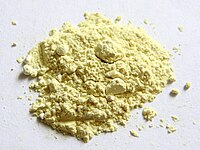
Photo from wikipedia
To obtain the influence of the Bi2O3 particle content of a PTFE/Al/Bi2O3 reactive material (later referred to as PAB) on its shock-induced chemical reaction (SICR) characteristics, five kinds of PAB… Click to show full abstract
To obtain the influence of the Bi2O3 particle content of a PTFE/Al/Bi2O3 reactive material (later referred to as PAB) on its shock-induced chemical reaction (SICR) characteristics, five kinds of PAB with different Bi2O3 contents were prepared; the reaction process in a drop-hammer test, recorded using a high-speed camera, was analyzed. The ignition and reaction mechanisms of PAB under mechanical impact were analyzed based on the thermochemical reaction characteristics and the microstructure. The results show that with an increase in Bi2O3 content, the shock-induced chemical reaction duration and the sensitivity of PAB increase, and then decrease. When the Bi2O3 content is 9%, the impact sensitivity is the highest and the reaction duration is the longest. The heating at the crack tip is responsible for PAB ignition under long-pulse low-velocity impact. During ignition, PAB undergoes several physicochemical changes such as the melting of PTFE, a PTFE/Bi2O3 reaction, an Al/Bi2O3 reaction, pyrolysis of the melted PTFE, and a C2F4/Al reaction; moreover, the presence of Bi2O3 decreases the excitation threshold of the reactive material, which facilitates the propagation of the reaction and improves the degree of the reaction and overall energy release of the reactive material.
Journal Title: Polymers
Year Published: 2022
Link to full text (if available)
Share on Social Media: Sign Up to like & get
recommendations!